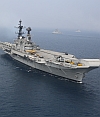INS Viraat was originally commissioned by the British Royal Navy as HMS Hermes on November 18, 1959. Between 1959 and 1970, Hermes served as one of the Royal Navy's four Strike Carriers, mainly operating in the Indian Ocean.

In 1970, she switched to her second existence as a commando carrier or landing platform helicopter. Her third avatar, between 1976 and 1980, was of an anti-submarine warfare carrier with the option to revert to the LPH role at short notice.


In 1982, Hermes saw action in the Falklands under the command of Captain Middleton where she distinguished herself as the Flagship of the Royal Navy in the campaign to regain Falklands and South Georgia from Argentina. The 100-day war in hostile weather saw the Sea Harriers undertake 2,376 sorties and shoot down 23 enemy aircraft with the loss of only one aircraft to enemy fire. The 108 continuous days at sea, without a single major defect, under difficult combat and sea conditions, were her finest hours.
INS Viraat was commissioned into Indian Navy on May 12, 1987 at Plymouth, United Kingdom by Dr P C Alexander, then High Commissioner of India to UK. The ship operated Sea Harrier (White Tigers-fighter aircrafts), Seaking 42B (Anti-Submarine helicopters), Seaking 42C (Commando Carrier helicopters) and Chetak (SAR helicopter) as her main air elements. The Sea Harrier fleet was decommissioned at Goa in May 2016.


Under the Indian Flag, various aircraft have flown over 22,034 hours from the deck of INS Viraat. The aircraft carrier has spent nearly 2,250 days at sea sailing 5,88,288 NM (10,94,215 KM). This implies that Viraat has been at sea for almost 7 years covering the entire globe about 27 times.
INS Viraat's first major operation was 'Operation Jupiter' in July 1989 as a part of Indian Peace Keeping Operations in Sri Lanka in the wake of the breakdown of the Indo-Sri Lankan Accord of 1986. On July 27, 1989, the ship mounted 76 helo sorties off Kochi to embark over 350 army personnel and over 35 tons of stores of the 7 Garhwal Rifles.


INS Viraat played a pivotal role in Operation Parakram following the terrorist attack on Parliament in 2013. The ship also played a key role during Operation Vijay, creating a blockade against Pakistan during the Kargil War in 1999.
The motto of INS Viraat 'Jalamev Yasya, Balamev Tasya' (One Who Controls the Sea is All Powerful) is truly reflective of the role that she is expected to discharge in furtherance of the nation's maritime goals. The crest of INS Viraat depicts an eagle with five arrows. The eagle symbolizes air power and the five arrows held in the talon represent the ship's versatile weapon capability. The ship is affiliated to Garhwal Rifles and Scouts, an elite infantry regiment of the Indian Army, since their joint participation in Operation Jupiter.

INS Viraat has a standard displacement of 23,900 tons and a full load displacement of 28,700 tons. The total length of the warship is 226.5 meters and the breadth is 48.78 meters. The ship is manned by 150 officers and 1500 sailors.


The ship is like a mini-city complete with attendant logistics infrastructure libraries, gymnasiums, onboard ATM counter, a TV and video studio. A full-fledged hospital and dental centre function onboard to cater to any emergencies.

Present Chief of Naval Staff Admiral Sunil Lanba served as an Executive Officer of INS Viraat. Former heads of Indian Navy Admiral (Retd) Madhavendra Singh, Admiral (Retd) Arun Prakash, Admiral (Retd) Nirmal Kumar Verma and Admiral (Retd) Devendra Kumar Joshi have also served as Commanding Officers of INS Viraat.